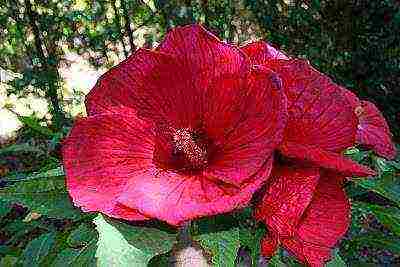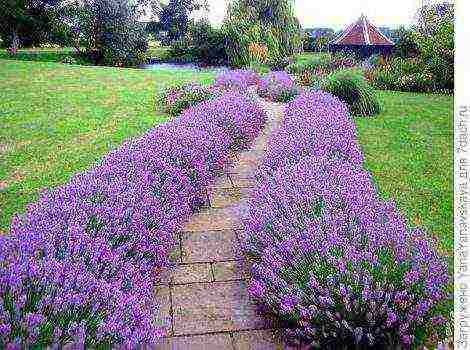Content
- 1 Description and characteristics of dogwood
- 2 Growing dogwood in the suburbs
- 3 Features of planting dogwood
- 4 Dogwood care
- 5 Diseases and pests
- 6 Popular varieties of dogwood for the Moscow region
- 7 Winter hardy dogwood varieties
- 8 Reviews about growing dogwood
- 9 Maturation of dogwood in the Moscow region, Krasnodar Territory and Ukraine
- 10 Reproduction of dogwood seeds at home
- 11 When to plant dogwood in different regions of Russia?
- 12 How to prepare a seedling?
- 13 Choosing a place for planting in a garden or cottage
- 14 Description of the process of planting seedlings on open ground in the fall
- 15 Shrub Care is an Important Moment for Getting a Good Harvest
- 16 How to transplant an ordinary dogwood?
- 17 Why is dogwood unpopular in cold regions?
- 18 Place for planting southern shrubs
- 19 Where to get planting material
- 20 How to plant dogwood
- 21 Shrub planting
- 22 Does an unpretentious dogwood need care
- 23 Conclusion
For the gardens of the Moscow region, dogwood is a rare plant. Gardeners do not trust the southern tree too much, but this attitude is wrong. Dogwood copes with frosty winters, is unpretentious in care and is not susceptible to diseases. But in order for this tree to become a decoration of the site, you need to choose the right variety.
Description and characteristics of dogwood
Wild dogwood is found in the mountain forests of the Caucasus and Crimea, in the light sunny forests of Central, Southern Europe and North America. In the Asian part of the globe, the plant is widespread in Japan, China, Asia Minor.
In the Turkic language, the name sounds like "kyzyl" and literally means "red", which coincides with the color of ripe berries.
Many legends and signs are associated with dogwood. In the East, the plant is called the "shaitan berry", and Christians believe that the Holy Cross is made of dogwood wood.

According to the sign, the more dogwood berries on the branch, the colder the winter will be.
Dogwood characteristics
Cornelian cherry is a deciduous tree or multi-stemmed shrub. Under natural conditions, tree specimens grow 5–7 m in height. In a favorable environment, there are trees 10 m high. The branches are spreading, horizontally located. The bark is dark gray in color. Leaves grow opposite each other, within 8 cm long. The leaf surface is decorated with 3-5 pairs of arcuate veins. The top of the leaf plate is shiny, bright green, the underside is lighter. The flowers are bisexual, collected in inflorescences, umbrellas, 15–20 pcs. Flowering occurs in April at a temperature of 8–12 ° C, earlier than leaves appear.
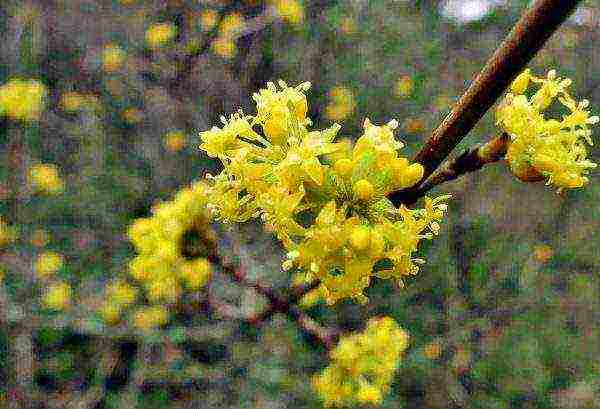
Cornel in the Moscow region blooms in early April for 10-15 days
The dogwood fruit is a drupe, differing in size and shape. The berries are long or short oval, pear-shaped or round. On average, the fetus weighs 2-6 g. The surface of the fruit is often smooth, sometimes bumpy. Coloring is presented in all shades of red, but yellow, dark purple or black are found. The stone is oval-elongated.
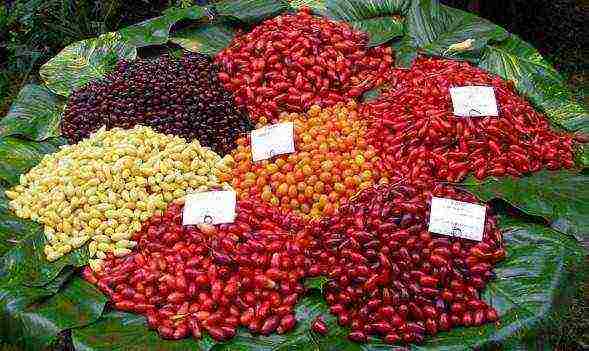
Modern dogwood varieties go beyond the traditional red color
Fleshy juicy pulp makes up 68–88% of the fruit mass.The taste is sweet and sour, reminiscent of wild rose, and after the berries, a slight astringency is felt in the mouth. Dogwood has lived in one place for over 100 years. The plant is fast-growing, but if grown from a stone, the appearance of fruits is expected in 7 years. The yield increases with age. Twelve-year-old trees yield 25-30 kg of red berries, 25-year-old trees - up to 100 kg. And at 50 years old, a crop of 150 kg ripens on the dogwood. Of the southern fruit plants, dogwood is the most frost-resistant. Cases were recorded when trees withstood cold below 35 ° C. It is not frosts that are dangerous for dogwood, but winter thaws and spring return frosts. The plant does not have time to restore the level of winter hardiness. In addition, rain and fog during flowering reduce yields.
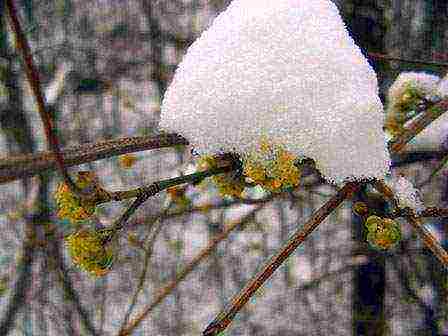
Returnable spring frosts turn into crop failure for the tree
Dogwood is self-fertile, so you need to purchase a couple of seedlings. If there is not enough space for the normal placement of plants, a branch of a different variety is grafted into the crown of the planted one. The plant easily tolerates dry periods due to its developed roots. The vertical root extends 1 m deep into the ground, and the fibrous part is located higher, 20–60 cm below the soil surface. Cornel is highly immune, no specific diseases have been identified.
Growing dogwood in the suburbs
Despite its heat-loving nature, dogwood has been growing and bearing fruit in the Moscow region for many years. The plant appeared in the Main Botanical Garden of the Russian Academy of Sciences back in 1950, so the dogwood grove has 50 trees up to 3 m high.But distrustful gardeners do not risk planting dogwood in the gardens, doubting their ability to survive the difficult winter conditions. And in vain, because the dogwood is a picky plant that can survive in thirty-degree frosts. Even if the plant is damaged in winter, it will easily recover in spring, as it gives many root shoots.
Dogwood is easy to care for, which will allow even a novice gardener to try his hand at growing southern berries.
Video: rules for growing dogwood
Features of planting dogwood
So that the dogwood can quickly adapt, they keep the planting time and carefully choose a place for the plant.
Planting dates for dogwood
It is preferable to plant dogwood in late September - early October. If the timing is determined by folk signs, then the procedure should be started as soon as the foliage falls from the poplar. It is impossible to delay planting, the seedling takes root for 3 weeks, and frosts are destructive. Autumn planting will allow:
- purchase strong planting material at a reasonable price;
- simplify the rooting of a tree in a new place in wet ground. By the spring, the dogwood will acquire a mass of roots that will help the plant grow rapidly;
- save time and effort. The tree is watered once, the rest will be completed by the rains and the relatively mild climate of the Moscow region.
In the spring, planting dogwood is worth hurrying, because the growing season begins rapidly. You need to plant the plant before the first flowers appear and only in the heated soil.
Choice of soil and place for planting
For a dogwood, an illuminated area in the southern or southwestern part of the garden with a little shading is suitable, since in nature the plant lives in light sparse forests. Light partial shade is important for young plantations. Over time, the dogwood grows and becomes spreading, so the tree is placed at a distance of 3-5 m from the boundaries of the site. In addition, dogwood is planted on the leeward side of buildings or fences. Flat areas are suitable for planting, but a slight slope of 5-10 degrees is also allowed. Neighborhood with fruit trees will not harm dogwood, but you cannot plant a plant under a walnut - it will not take root. In relation to soils, dogwood is undemanding, it will grow even in heavy clayey areas with high acidity. But the quality of the harvest and the development of the tree will suffer under such conditions. Dogwood is suitable for light soils with aeration and nutrients, moderately water-absorbing. It is worth adding a clay fraction and lime to the ground to retain water.
Dogwood will not grow in wetlands where the water table is above 1 m to the surface.
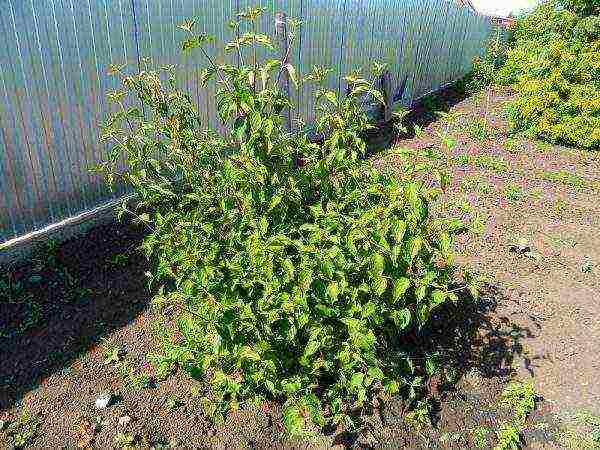
As a rule, dogwood is planted along the borders of the site so that the shadow from the dense crown does not cover other plants from the sun.
Sapling selection
Only a strong and healthy seedling is able to give growth, therefore, when buying planting material, it is worth evaluating a tree according to the following criteria:
- roots with elastic lateral branches of 25-30 cm, without signs of disease;
- the trunk diameter is at least 2 cm, the bark is smooth, without damage. Fresh green wood under the bark. If it is brown, the seedling is not viable;
- the age of the seedling is 1-2 years. The height of the tree is 1.2–1.6 m, around the trunk there are 3-5 branches.
Flower buds are already formed on two-year-old seedlings, and the plant is ready to bloom the next year after planting.
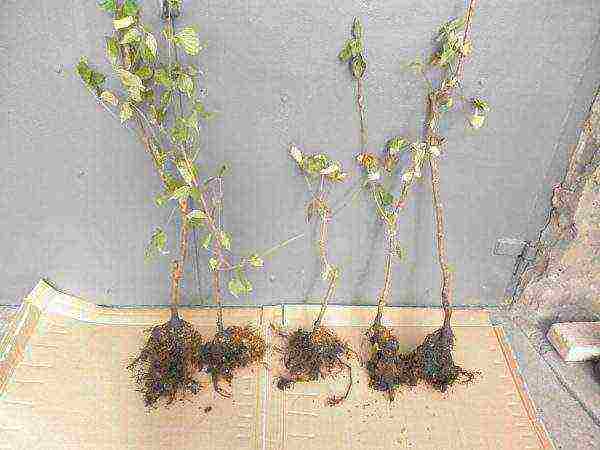
You need to buy seedlings in the fall, then the plant will take root and give strong roots in the spring
Preparing the pit for planting
It is extremely important to cultivate the soil and properly prepare the planting pit, given that the dogwood grows in one place longer than other fruit crops. For autumn planting, preparatory work begins in the spring. The selected area is freed from plant residues, perennial weeds are removed. The acidic soil is limed, and to improve the quality of the land, compost or manure is introduced at 5 kg per 1 m2. After that, the surface is leveled and harrowed to retain moisture. In the summer, they begin to prepare the landing pit.

The dogwood pit is prepared in the summer so that the fertilizers applied are mixed with the soil.
Creating a planting pit step by step
It is not difficult to make a landing pit if you adhere to the following rules:
-
Dig a depression 80x80 cm. If the soil is prone to excessive accumulation of moisture, make the depression a little deeper, and lay drainage (broken brick or crushed stone) on the bottom.
-
Drive a peg-support 80–100 cm high into the untouched bottom of the pit. Place it on the side where the wind is blowing.
-
When digging, put the top fertile layer to one side, and the ground raised from the depths to the other. Add organic matter and mineral fertilizers to the fertile soil:
- humus or manure - 1 bucket;
- superphosphate - 200 g;
- ammonium nitrate - 50 g;
- wood ash - a half-liter jar.
To give the soil the desired structure, pour a bucket of water into the filled hole.
Planting dogwood
Before planting, the tree is carefully examined, damaged branches are removed. If the roots are dry, they are dipped in water for 1–2 hours to revive, and then they are dipped in a clay mash for 10–15 minutes. The pit planting process is simple:
- In the center of the hole, make a mound of soil.
- Place the seedling on a raised platform, gently straightening the intertwined roots.
- Cover with earth and press down. After planting, the root collar should rise 5 cm above the ground level.
- Tie the seedling to a support. For autumn planting, carefully remove the foliage from the branches so as not to damage the ovary.
- Form a watering circle around the seedling and pour water into it at the rate of 30–40 liters per plant.
- When the water is absorbed, mulch the near-stem area.
It is worth planting dogwood carefully, as the fibrous roots can be damaged.
Video: the process of planting dogwood
Dogwood care
A picky dogwood will grow even a novice gardener.
Watering
Dogwood roots are able to receive moisture from the soil even with rare precipitation. Despite the dogwood's ability to endure dry periods, the plant is responsive to watering. Mature trees are more resistant to water shortages than young trees, but when fruiting, the moisture deficit will result in the drying out of the berries. Kidneys in the absence of water are not laid. In a thirsty plant, the leaves are folded in a boat to reduce evaporation. Young, immature trees need regular watering in the first growing season after planting. Cornel should be watered with water that has settled and warmed up in the sun. The water consumption rate for a tree will be 2 buckets under a tree 1 or 2 times a week.To avoid unnecessary moisture loss, mulch should be used after watering.
Dogwood is sensitive to waterlogging. Spring precipitation near Moscow should be taken into account when drawing up an irrigation schedule.
Top dressing dogwood
Gardeners differ in their opinions on top dressing. Some believe that dogwood grows and bears fruit without fertilization. Others, on the other hand, indicate an improvement in the quality of the crop and the development of the tree after adding organic matter to the soil. Be that as it may, the dogwood reacts to fertilizing, both mineral and organic. Depending on the season, different types of fertilizers are chosen:
- at the beginning of the growing season and in the process of growth, it is better to use nitrogen-phosphorus compositions - 40-50 g per plant;
- in the summer, a solution of chicken manure is used, diluting the fertilizer with water in an amount of 1 to 10;
- closer to autumn they feed 10–12 g of potassium per tree;
- in spring or autumn, humus or rotted manure is introduced, using organic matter as mulch or for digging. For 1 m2, 2-3 kg is enough;
- in the fall, before digging, ash is added to the soil.
On acidic soils, do not forget about lime, since the dogwood needs calcium for fruiting.
Tree pruning
The dogwood is pruned in early spring, being careful not to damage the thin bark. Crown formation is carried out in the first years after planting. First, a bole with a height of 50–70 cm is drawn up, removing the shoots starting from the planting level. 5-7 strong shoots are left as skeletal branches. The crown is formed in the form of a neat oval or compact pyramid.
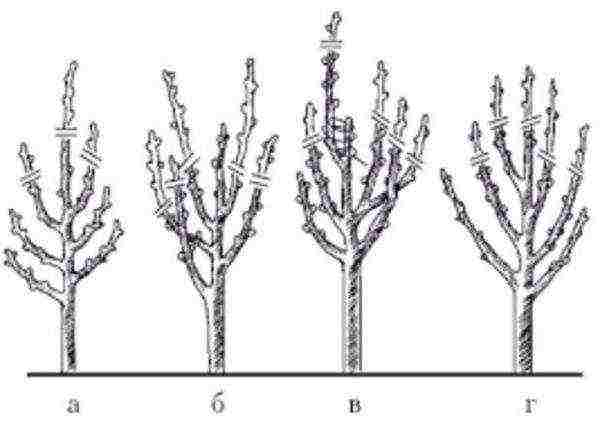
Cornelian crown is formed oval or pyramidal for rapid growth of branches and ripening of berries
In the future, gardeners monitor the cleanliness of the standard area, remove broken or dried branches in time, sometimes carrying out thinning pruning. The tree is rejuvenated 15–20 years after planting.
Dogwood lends itself to formation without problems, becoming a decoration of the site. To do this, the skeletal branches are tied to the pegs in the right direction, and then the trellises are installed and shoots are allowed to run along them.
Barrel circle care
The process includes weeding the near-stem space. The next day after watering, the soil is loosened to prevent the formation of an earth crust that interferes with normal gas exchange. Mulching is also not neglected, which combines the functions of feeding and preserving moisture in the roots, and also prevents the growth of weeds.
Preparing dogwood for winter
Despite its frost resistance, young dogwood with fragile roots must be protected in winter. After falling leaves, it is worth removing the fallen leaves and a layer of old mulch. To insulate the surface absorbent roots, a layer of manure or humus up to 20 cm high is laid, collecting a mound around the trunk. Dogwood seedlings for the winter are covered with non-woven covering material. Burlap, lutrasil, or agrofibre will do.
Winter in the Moscow region is moderately cold with a stable snow cover. If you form a snowdrift around the dogwood, it will serve as a natural protection for the roots.

This covering material is breathable, but protects the plant from frost
Diseases and pests
A healthy dogwood rarely suffers from diseases and pests. But an attentive gardener should periodically check the condition of the trunk, branches and leaves so as not to miss the initial stage of developing infection or the appearance of insects.
Table: Disease and Insect Control Measures
Photo gallery: dogwood diseases and pests
Popular varieties of dogwood for the Moscow region
Thanks to breeding work, many varieties of dogwood have appeared, which grow in the conditions of the Moscow region. These are trees with an early and medium ripening period, which fits into the particular weather conditions of the area. A seedling brought from the south will not take root in the new conditions, but the zoned varieties will give yields:
- Nastya. The plant is medium in size, the crown is not too dense. The bark of the trunk is gray, flaky.The leaf bud is gray-green, the flower is gray-yellow, with a crimson blush. Leaf size is medium to large. The plates are slightly elongated, with a slight sharpening. The dark green surface is matte, wrinkled, slightly pubescent. The leaf is concave, like a boat. The fruits are colored red, the average weight of the drupe is 5 g. The pulp is red, medium coarse, sweet and sour. Average yield 104 c / ha. The variety is prized for its fast ripening. Fruits for universal use. The tree resists disease and pests.
- Coral Stamp. Medium-sized plant, oval fruits, like cherry plum. The variety is large-fruited, berry weight 5.5–6.5 g. The color of the drupe is orange-pink. The taste of the variety is sweet and more like a cherry than a dogwood. The bone is easily separated from the juicy pulp. Ripe fruits crumble, so it is better not to delay with harvesting. The variety is ready for harvesting on August 15–20. Up to 35 kg of harvest is harvested from a 15-year-old tree. Berries are versatile in use.
- Vydubetsky. The plant is vigorous, up to 4 m. Oval-pear-shaped fruits weighing 6.5–7.5 g. The skin is thin, shiny, colored dark red. At the stage of full ripeness, the berries acquire a pomegranate hue. Sweet and sour, juicy and tender pulp with a dense consistency. Ripe fruits do not crumble, which makes picking easier. The variety is famous for its yield - up to 50 kg per tree, keeping fruit stable, not damaged during transportation. Frost resistance up to -25 ° C.
- Firefly. A tree up to 2.5 m high. Crohn with a diameter of 3 m, oval. Fruits weighing 7–7.7 g, bottle-shaped with a thickened neck. The color of the ripe fruit is red-black. Sweet and sour flesh, pleasant to the taste, is dense, aromatic. Dogwood ripens in the last week of August or early September. Ripe berries do not crumble. Fruits are dying, after harvesting they are not deformed for 4 weeks. Annual fruiting is noted; on a 15-year-old tree, up to 60 kg of berries ripen per season, suitable for processing and freezing.
- Lukyanovsky. A three-meter tree with a beautiful, medium thickened, rounded crown. Fruits are one-dimensional, pear-shaped, weighing 5 g. During full ripening, the dark red skin turns black. The pulp near the stone brightens. The consistency is firm but delicate. The yield increases with age, 10–25 kg are removed from a 10-year-old tree, 45–60 kg from 15–20-year-olds. The harvest ripens in the first decade of August. The berries plucked ahead of time ripen, they tolerate transportation without any problems. The variety is appreciated for its easy care, the ability to endure frosty and dry periods. Berries for universal use.
- Eugene. Fruits are oval-drop-shaped, large and shiny. Berry weight 6–8 g. Thin, but dense skin is colored dark red, which turns black in ripe drupes. The pulp is dark red, tender, sweet and sour taste, easily lags behind the stone. The berries are of medium ripening, the harvest is ready for harvesting in the third decade of August. The variety is famous for its annual harvests; a 15-year-old tree bears 40 to 50 kg of berries. The fruit can be stored in the refrigerator for up to five weeks. The variety is chosen for drought and frost resistance.
- Elegant. Fruits are elongated, slightly flattened. Weight within 9 g. The skin is glossy, colored in cherry-burgundy, close to black, shade. The dark red pulp is dense, separates from the stone, the taste is sweet with a slight sourness. Stable fruiting, yield per tree - up to 45 kg. The variety is distinguished by its transportability and high resistance to diseases, no cases of infection by viruses and fungi have been recorded. The tree can withstand frosts down to -25 ° C.
Photo gallery: varieties zoned for the Moscow region
Winter hardy dogwood varieties
Thanks to the work of breeders, dogwood takes root and bears fruit in regions with harsh winters. For the cold weather near Moscow, the following varieties have been bred:
- Elena. Round-oval one-dimensional fruits weighing 5–8 g. The surface of the berry is covered with a thin and shiny dark red skin.The flesh separating from the stone is colored red, tender and juicy. The taste is dominated by sweetness, the sugar content reaches 7.7%. The tree is harvested early - at the end of August. You need to remove the fruits on time, since the berries are prone to shedding. Annual yield, with indicators of 22–42 kg, the variety is resistant to diseases. Shoots can withstand temperatures down to -35 ° C and can be transported without problems. The Elena variety is useful fresh, but also suitable for blanks.
- Nikolka. The fruits are ready to be harvested in late July - early August. Berries are one-dimensional, elongated-oval, with slight asymmetry, weighing 5–8 g. Ripe fruits are dark red. Uniformly colored pulp is tender and juicy, dense in consistency, fragrant. The taste is sweet with a slight sourness. An adult tree produces 35 kg of berries. The variety is resistant to diseases, can withstand frosts of thirty degrees. Berries for universal use.
- Vyshgorodsky. Early ripening variety, ripens in early August. The berries are elongated-rounded, weighing 4–6 g. The skin is shiny, dark red, the flesh is firm and juicy. The taste is intense, sweet and sour. The yield is 35–42 kg per tree. The fruits are transportable, stored for a long time, do not lose their beneficial properties after processing. Disease resistance is high, shoots easily tolerate frost.
- Grenadier. It is appreciated for the early ripening of berries - in early or mid-August. Rounded-elongated fruits weighing 5-9 g are covered with a glossy red skin. The pulp is of medium density, sweet and sour taste. The yield is stable, 45 kg of berries are harvested from one tree. The variety is well stored and transported. Immunity is high, the tree is winter-hardy. The fruits are used both in preparations and fresh.
Photo gallery: varieties that are not afraid of frost
Reviews about growing dogwood
Cornel is a useful berry, which is not difficult to grow in a garden near Moscow. With minimal care in autumn, the tree will delight with a harvest of berries with an unforgettable taste.
Dogwood is not often found in our area. But since this plant has unsurpassed useful properties, it is worth considering how to start growing it in a summer cottage.
Planting a dogwood and subsequent care for it is an absolutely not complicated procedure, which even for a novice gardener can do.... This shrub is unpretentious, and at the same time has delicious berries.
Maturation of dogwood in the Moscow region, Krasnodar Territory and Ukraine
Kizil prefers the warm climate of the Caucasus and Transcaucasia, where it grows in mountain forests, on sunny edges, as well as in thickets of other shrubs. In addition, it grows in the territory of Ukraine, Crimea, Central and Southern Europe, as well as in Western Asia. On the territory of Russia, dogwood is successfully cultivated in various regions - Moscow region, Krasnodar Territory and other regions.
The beginning of flowering of the common dogwood falls on March, and the end - in April. Fruits ripen closer to the middle of autumn, depending on the region of growth. When the fruits are ripe, they begin to fall off the bush. The ripeness of the dogwood fruit can be determined by taste.The crop is harvested every year in September, and the roots are harvested at the end of November..
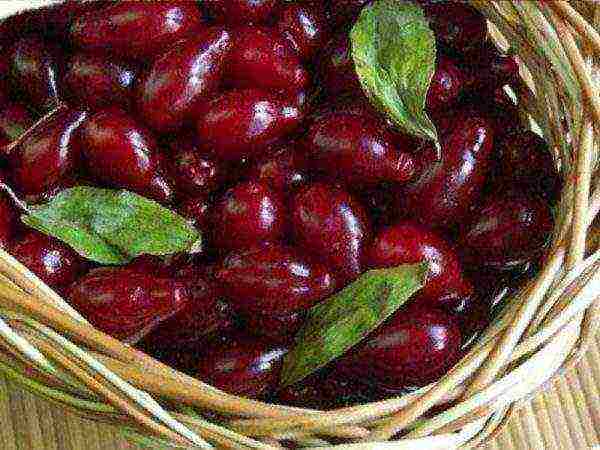 Freshly picked dogwood berries
Freshly picked dogwood berries
For long-term storage of berries at home, they are cut off as they begin to ripen. The fruits are placed in small baskets where they ripen., and then stored at a temperature of 0 - +2 C.
Nice, sweet and sour tasting with a specific aroma, dogwood fruits are often consumed fresh, and experienced housewives are in a hurry to buy dogwood to make exquisite jams, jellies, jams, juices, compotes, marmalades, or simply fill the fruits with sugar and store. Also, berries can be preserved by freezing.
In its raw form, dogwood berries are stored in a refrigerator (in a plastic bag with holes) for no more than 12 days.
Reproduction of dogwood seeds at home
Dogwood can be propagated using a bone, i.e. germinate it.To do this, take ripe berries, free the bone from the pulp and place them in boxes with wet sawdust or moss for one year, regularly maintaining a moist environment. This method is used to stratify the seeds before planting them. The seed of this plant is not divided into cotyledons. In this regard, it should be placed in the ground no deeper than 3 cm. Unstratified seeds germinate only after 2 years, while not all... Sprouted seeds germinate in the year they are sown.
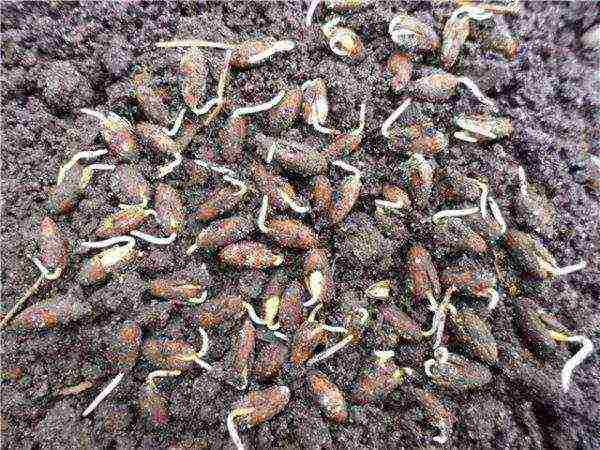 Sprouted Dogwood Seed
Sprouted Dogwood Seed
Taking care of the seeds is simple: watering, feeding, at the beginning of growth, shading from hot sunlight. During the first year, seedlings grow up to 3-4 cm, by the end of the second - up to 10-15 cm... The kernels of the seed-grown dogwood are harvested after 7-10 years from the moment of sowing.
The varietal properties of the dogwood, like all fruit plants, retains during vegetative propagation. Dogwood can be propagated by grafting, green cuttings and replants. The most efficient way - reproduction by budding, the survival rate of the eyes is 92-97%
When to plant dogwood in different regions of Russia?
The best period for planting shrubs on open ground in the southern regions is autumn. It is not difficult to determine the time for planting dogwood - as soon as poplar leaves begin to fall... It is recommended to plant this plant in the fall, since during spring planting it is necessary to plant it in a rather short time: between the time the soil warms up and the period when the buds of the bush begin to bloom.
In the autumn period, dogwood is planted no later than mid-October, 2-3 weeks before the onset of frost... Well-watered and well-watered shrubs manage to take root, tolerate winter well and begin to grow rapidly in early spring.
Advantages and disadvantages of autumn planting
Autumn planting has several advantages:
- Cornelian seedlings planted in autumn manage to heal damaged roots during the winter and build up new suction roots by spring. Thanks to this, the young plant is able to withstand the early spring droughts and dry winds characteristic of the southern regions without complications.
- It is much more profitable to buy dogwood in autumn.... Gardeners and nurseries sell freshly dug planting materials, resulting in a huge selection of products at affordable prices.
- Autumn planting is quite a bit of a hassle... It is enough to do only one watering, and nature will do the rest of the work on its own. Rainy weather in autumn provides the dogwood with the necessary moisture and comfort.
- Another important advantage is saving time... Autumn planting of dogwood seedlings frees up a large amount of time and effort for other work, which becomes quite a lot with the onset of springtime.
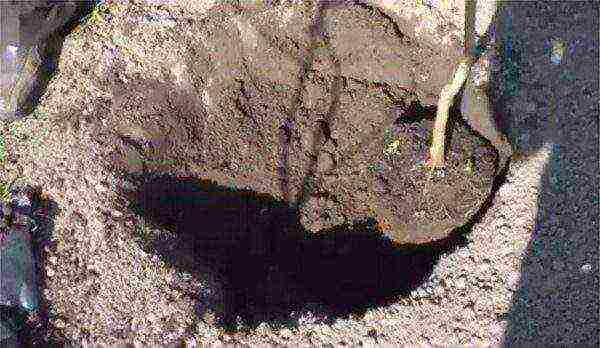 The soil for growing ready-made dogwood seedlings should be prepared in the summer.
The soil for growing ready-made dogwood seedlings should be prepared in the summer.
Autumn planting also has certain disadvantages.:
- Severe frosts can ruin still immature plants.... In winter, there are strong winds, snowfalls and other weather adversities that can break young trees and shrubs.
- Rodents pose a danger to shrubsfeeding on seedlings in late autumn and winter.
Sometimes freshly picked cornel berries with pericarp are planted in August. Germination in this case is 70-80% after 1.5 years from the day of sowing..
Important rules when planting dogwood
During planting, certain rules must be followed.:
- It is advisable to plant dogwood in a shaded place., between the trees. Thus, you can save the area of the garden and solve the problem of using low-light areas on the site.
- When choosing a site consideration should be given to the placement of groundwateras the dogwood root system branches out at a level of 1 m from the ground surface.
- For good yields it is recommended to plant several different plant varietiesme, because they bloom at the same time.
- When planting a bush humus, manure, mineral fertilizers are not used... All you need is land and water.
Below is a detailed description of the process of planting dogwood in the garden.
How to prepare a seedling?
During the acquisition of seed, attention should be paid to the root: the more powerful it is, the faster the plant will develop. Weak, chapped, thin roots with obvious signs of soreness should be treated with concern. You need to purchase powerful seedlings with 2-3 root branches at least 30 cm in length... The bark on the trunk should be intact and the branches intact.
To fully ensure the viability of the plant you like, you need to slightly cut the bark. If the incision is green - means the choice is correct, if brown - you will have to continue searching for a suitable dogwood.
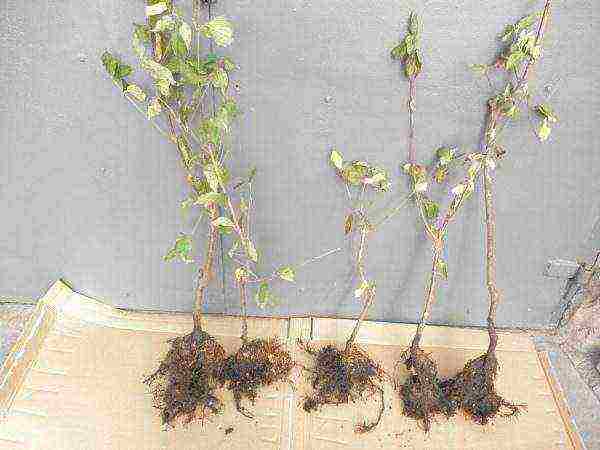 Before planting dogwood seedlings, they should be placed in water for several days.
Before planting dogwood seedlings, they should be placed in water for several days.
The seedling rhizome should be well moisturized. In the case of long-term transportation, it is wrapped in a damp material and placed in a plastic bag. If the roots have dried up during the transportation period, they should be placed in water for several days before planting.... If, after the purchase, it is not possible to immediately plant a seedling, it is added dropwise at an angle in a shaded place. It is important here that the soil covers all the roots, as well as half of the seed. A richly watered plant in this form can be stored for a month.
Choosing a place for planting in a garden or cottage
What is the most suitable place in the country for growing dogwood? Any site is suitable for an unpretentious dogwood. To harvest good yields, the soil must be fertilized, drained, moist and alkaline..
To test the acidity of the soil, you need to drip 2 drops of table vinegar on a handful of earth. In an alkaline environment, small bubbles appear, indicating the required amount of lime.
Dogwood does not take root in swampy soils. In addition, clayey areas and poorly lit areas should be avoided. For the first 5 years of growing this shrub, partial shade is perfect.... Then the dogwood can be transplanted into a sufficiently lit area of the garden. To save space, it is advised to plant a shrub between old trees, which, with their shadow, will protect its root system from drying out. Dogwood gets along with each of the fruit plants, the only exception is the walnut.
Description of the process of planting seedlings on open ground in the fall
Dogwood planting rules
To plant a dogwood correctly, you must follow the following steps:
- Before proceeding with planting, the plant should be carefully examined again and prune broken branches and damaged roots... Then it is good to process all the roots with a previously prepared clay mash. When planting in autumn, the foliage must be carefully removed from the dogwood.
- The recess for the seedling should easily accommodate the rhizome. Fit pit 30 - 50 cm deep.
- Digging a hole into it drive in a stake, to which you will then need to bind the plant.
- Place about 15 cm of pebbles at the bottom of the hole or expanded clay. If the soil is scarce, the drainage is covered by a third of leafy soil.
- Cornel prefers potassium-rich soil. You can enrich it with lime.mixed with the substrate in a ratio of 150 g to 1 mg.
- When placing a seedling in a hole, its roots must be carefully spread, and the root collar is under 2 - 3 cm of soil.
- Falling asleep the hole, you need to watch that voids do not appear around the roots. To avoid this the planted material should be trampled down and well wateredb.
- Shrub without fail mulch about 10 - 15 cm... This procedure is necessary so that the roots located superficially do not dry out. To do this, you can use pine needles, sawdust, straw or hay.
- 7 days after planting the bud near the dogwood should be compacted and watered again.
Shrub Care is an Important Moment for Getting a Good Harvest
Dogwood does not need special care. The main thing is to water it constantly for one year from the time of planting. Watering is carried out 2 times a week. To prevent water from spreading over the territory, it is worth making a furrow around the seedling.
In the first growing year, you need to monitor the condition of the leaves. If they begin to dry out and curl, this indicates that the plant does not have enough moisture. Same for the first 3 years, gardeners need to monitor the cleanliness of the soil near the dogwood... Weeds growing at a distance of 1 m from the plant should be disposed of.
To ensure improved air exchange of the layer in which the roots of the plant are located, it is necessary to periodically loosen the soil about 10 cm deep. To make it more convenient to deal with this process, it is necessary to loosen it the next day after watering.
For high yields, the shrub is fertilized several times throughout the year. It is believed that during the growing season, dogwood needs nitrogen-phosphorus supplements, and in the autumn, potassium supplements.
Some gardeners alternately add humus and compost, or every year at the beginning of the summer period they add water with chicken droppings under the plants in a ratio of 10: 1... Others make fertilizers from 0.03 kg of ammonium nitrate and one bucket of humus. At the end of August, 0.5 liters of wood ash is poured under an adult plant. And at the end of the harvest, it is advisable to add 0.1 kg of superphosphates. However, lime is recognized as the most important fertilizer. Thanks to her, potassium is present in the soil, which affects the future number of fruits.
When caring for dogwood, regular soil tillage is essential.... It is carried out annually at least 6-7 times, regardless of the age and fertility of the shrub. They start processing in the spring, and finish in the fall, after collecting all the fruits. The final stage of loosening the soil around the plant is its mulching.
How to transplant an ordinary dogwood?
If there is a need to transplant a plant from one site to another, the technique of reproduction by dividing the bush is applied.
For one year, this method can be used in early spring or late autumn. The plant is removed from the soil and freed from old branches. The root is cleaned of soil, and the shrub is cut into several parts... The roots are trimmed, the old shoots are removed. After that, the individual parts are planted in prepared holes.
The common dogwood is a long-liver. It can produce excellent harvests for 100 years.... Therefore, if you plant a dogwood, it will delight more than one generation with its tasty and healthy berries.
For a long time, dogwood was not a very popular crop among gardeners in the Moscow region. Many perceived it only as a southern, heat-loving plant. But thanks to its good frost resistance and unpretentiousness, it gradually took its rightful place among other fruit crops.
Which varieties are right for the region?
Cornel is a low deciduous tree or shrub with sweet and sour fruits, often red in color, inside which there is an oblong stone. Dogwood blooms from late March to mid-April. The fruits ripen in late summer or autumn. The harvest time depends on the variety.
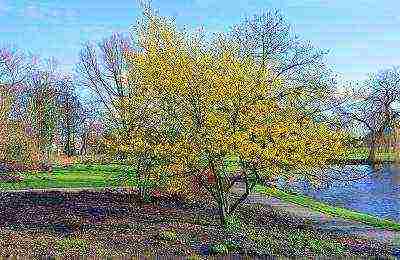 Wild dogwood is found in Asia, southern Europe, and the Caucasus. On personal plots, cultivated varieties are often grown, the fruits of which are large, bright in color and more pronounced taste.
Wild dogwood is found in Asia, southern Europe, and the Caucasus. On personal plots, cultivated varieties are often grown, the fruits of which are large, bright in color and more pronounced taste.
For a long time it was believed that dogwood is intended for regions with a mild climate. But today there are many known cases when dogwood was successfully grown and bore fruit in the Moscow region. Despite the fact that this is a southern culture, it easily tolerates frosts down to -30 C.Even if the plant is badly damaged by frost, it recovers well, "moves away" from the root.
There are many varieties and varieties of dogwood. Only a few of them are recommended for growing in the Moscow region:
- Vladimirsky. High-yielding variety. An adult, formed plant produces up to 60 kg of berries per season. The fruits are large (up to 8 g) and burgundy, almost black. The harvest ripens from late August to September.
- Vydubitsky. Mid-season, high-yielding variety. The berries are dark red, medium in size.
- Elena. An early, frost-resistant variety. It is characterized by a stable yield. The fruits ripen in early August. Berries are medium in size, resemble barrels in shape, deep red, glossy. The pulp is juicy inside, the bone is small.
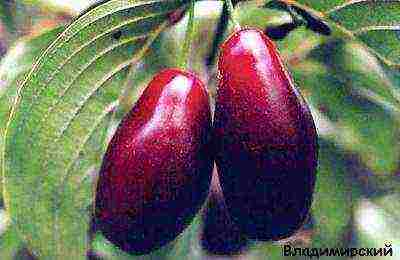 Nikolka. Early variety. Ripening of berries occurs simultaneously in the period from late July to early August. The size of the fruit is medium, the color is dark, almost black.
Nikolka. Early variety. Ripening of berries occurs simultaneously in the period from late July to early August. The size of the fruit is medium, the color is dark, almost black.- Firefly. Large-fruited, high-yielding variety of medium ripening. Harvested in the second half of August. The berries are red-black, shaped like a bottle. The pulp is burgundy, sweet.
- Semyon. Late-ripening variety. Ripening does not occur simultaneously from early September to early October. The berries are large, pear-shaped, dark cherry in color.
- Amber. It is distinguished by the amber-yellow color of the berries, which become almost transparent as they ripen. Fruits are medium-sized (up to 4 g), thin-skinned. Ripen from late August to mid-September. If necessary, the berries can be picked still unripe, they will "reach" at home.
Almost all dogwood varieties are characterized by high resistance to low temperatures and drought.
The difficulty of growing dogwood in the Moscow region is associated with the early flowering of the plant, when the spring weather in the region has not yet been established. Prolonged spring frosts can ruin the harvest. In addition, in early spring, pollinating insects may not yet recover from hibernation.
Features of planting and care
Agrotechnics of dogwood, planting and caring for it in the Moscow region is not much different from the cultivation of this crop in other regions. Cornel is an unpretentious plant. It adapts to any conditions and any soil.
It develops best in clayey, lime-rich, well-moistened soil. Loves the sun, but belongs to shade-tolerant crops.
Landing
It is better to plant dogwood in the Moscow region in the fall. For planting, experts advise choosing 1-2 year old seedlings, on which lateral shoots have already been formed.
Planting seedlings is carried out as follows:
Tips from PROFESSIONAL GARDENERS
Many of our readers for a RICH HARVEST actively use effective biofertilizer
Biogrow
... This fertilizer is suitable for all types and varieties of cultivated plants. Allows
increase yields by 50%
NO hazardous chemicals. And all that is needed for this is to add biofertilizer to the soil 2-3 times per season.
- Choose a warm place, protected from drafts.
- Prepare a planting pit of such a size that the roots of the plant are freely located.
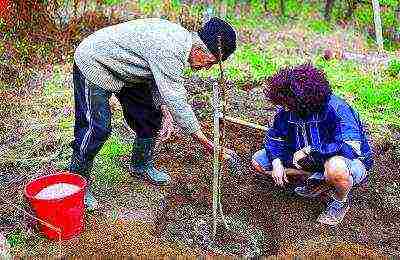 A mixture of fertile soil, organic and mineral fertilizers is poured into the bottom of the pit, and poured with water.
A mixture of fertile soil, organic and mineral fertilizers is poured into the bottom of the pit, and poured with water.- When planting, the seedlings are covered with earth to the grafting site.
- After planting, the plant is watered abundantly so that the earth tightly envelops the roots.
- The trunk of the seedling is shortened by a third.
- The soil in the near-trunk circle is mulched. For this, you can use humus.
For better pollination, it is recommended to grow several trees or shrubs at once in one area. It should be borne in mind that one tree can grow 3–4 m. For the first few years, the plant is covered for the winter.
Watering and pruning
The dogwood has a massive root system located on the surface. This allows the plant to absorb even slight summer rainfall.Young dogwood requires abundant watering, but as it ages, it becomes drought tolerant. When an adult plant does not have enough moisture, its leaves curl up into a boat. This reduces the evaporating surface and retains most of the liquid inside.
 Dogwood can be grown as a shrub or as a tree. Forming it as a tree provides for regular pruning of shoots that appear below 50–70 cm. A formed tree or shrub needs only sanitary pruning of frozen, damaged or intertwined branches. For plants that have reached the age of 20, it is advisable to carry out anti-aging pruning. It is done in early spring, before the onset of sap flow. Pruning does not affect the yield of dogwood in any way.
Dogwood can be grown as a shrub or as a tree. Forming it as a tree provides for regular pruning of shoots that appear below 50–70 cm. A formed tree or shrub needs only sanitary pruning of frozen, damaged or intertwined branches. For plants that have reached the age of 20, it is advisable to carry out anti-aging pruning. It is done in early spring, before the onset of sap flow. Pruning does not affect the yield of dogwood in any way.
Top dressing
Dogwood, although an unpretentious plant, is recommended to be fed for better fruiting. Fertilizers are applied under adult trees and shrubs several times a year:
 in the spring, during the formation of buds, one bucket of manure diluted with two buckets of water is applied under each plant;
in the spring, during the formation of buds, one bucket of manure diluted with two buckets of water is applied under each plant;- at the end of summer, you can feed it with potash preparations or wood ash;
- in the fall, after harvesting, a bucket of Organics and Superphosphate are introduced into the soil.
It is better to mulch the soil after fertilization.
Pest and disease control
Dogwood is very rarely exposed to diseases and pests. But sometimes in the middle of summer, yellow or brown spots appear on its leaves, weakening photosynthesis. They arise due to the defeat of fungal diseases.
To prevent the spread of the disease throughout the plant, you must:
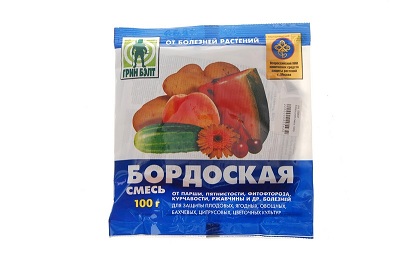 remove and burn the affected parts of the plant;
remove and burn the affected parts of the plant;- spray with Bordeaux liquid (at the rate of 100 g per 10 liters of water) or another fungicide;
- re-spraying after 2-3 weeks, but no later than 20 days before harvesting.
For the purpose of prevention, trees growing nearby can be treated.
Reproduction
Dogwood is propagated in several ways:
- Vaccination (budding). A vegetative bud from a scion is grafted into a T-shaped incision on the bark of the rootstock. The vaccination site is tied with a special garden tape. If everything is done correctly, the kidney begins to develop in 1-2 months. But in the conditions of the Moscow region, the vaccine often does not take root.
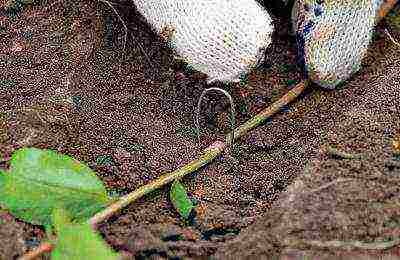 Layers. The young twig is buried in earth. It is shed abundantly throughout the season to form roots. When a young plant gets stronger, it is separated from the mother. One tree produces 6-8 layers per year.
Layers. The young twig is buried in earth. It is shed abundantly throughout the season to form roots. When a young plant gets stronger, it is separated from the mother. One tree produces 6-8 layers per year.- Seeds. The most suitable way for the Moscow region. Allows you to grow a seedling that will be adapted to the climatic conditions of the region. But this method does not guarantee that the young plant reproduces all the characteristics of the variety.
In specialized nurseries, they often use the method of rooting cuttings in special installations with constant temperature and humidity control. But using this method at home is almost impossible.
Dogwood is a long-liver. Even in the climatic conditions of the Moscow region, with minimal care, it can bear fruit for more than 100 years.
Do you still think that getting rid of cardiovascular diseases is impossible?
- do you often have pain and discomfort in the chest?
- it seems to you that the heart is almost "jumping out" of the chest, then freezes for a while ...
- you have shortness of breath even after minor physical exertion….
- headaches, poor sleep, feelings of weakness and increased fatigue ...
- legs swell in the evening ...
Stop enduring, you can no longer wait, delay treatment. Read what Elena Malysheva advises both for the treatment and for the prevention of diseases of the cardiovascular system ...
about the author
Project expert
Helpful article?
Residents of the middle lane know little about this wonderful berry; planting dogwood is mostly familiar to residents of the southern regions.In the Crimea and the Caucasus, jams and preserves are prepared from sweet and sour fruits, they are added to many national dishes. The plant is valued not only for its beneficial fruits, but also for its very durable wood. Depending on the preferences of the gardener, cultivation can be carried out in the form of both a tree and a bush.

Why is dogwood unpopular in cold regions?
Dogwood is unpretentious, it does not require complex care. In the southern regions, wild varieties form huge thickets, and the berries are not worse in taste than cultivated varieties. Frost is not terrible for a hardy tree, only temperatures below -30⁰ can damage its branches. If such phenomena are short-lived, young shoots can be covered, and they will winter well. Unlike fruit trees, which give good yields every 2 years, dogwood does not need rest, it bears fruit every season. Why is such a wonderful plant unpopular with summer residents in the middle lane and in the north?
The growing season of dogwood is about 250 days, and it blooms very early. Spring frosts in cold regions can destroy the ovaries, but even if the owners manage to preserve them, the fruits often do not have time to ripen. Breeders are working on a solution to this problem, species with early ripening of berries have already been bred. Planting and growing regionalized varieties often brings rich yields.
The common dogwood blooms when it is still cool outside, the temperature is about + 12⁰. In this weather, bees cannot pollinate flowers. For the wind to transfer pollen from one plant to another, plant at least 2 trees close to each other in the area. Some gardeners believe that the shrub can pollinate itself. Maybe, but the harvest will be very meager. But if you plant a bush of a different variety nearby and provide them with good care, almost all the flowers will turn into berries.
Advice
If it is impossible to find a place for another tree on the site, plant 2 seedlings of different varieties in one hole. Interlace the trunks and they will develop as one bush and pollinate each other.

Place for planting southern shrubs
Cornel is very fond of soils rich in lime, with a neutral or alkaline reaction. It is desirable that manganese is present in the soil, otherwise it must be added when feeding, this element is necessary for dogwood. He does not tolerate groundwater, the depth of their occurrence should be at least 1.5 m. In low areas, you need to make good drainage, and sometimes even make a fill mound.
The shrub does not like crowding, it needs that there are no fences, buildings, other trees or tall shrubs within a radius of 4-5 m. Cornelian cherry is a long-liver, it grows in one place for up to 100 years. Over time, the crown increases in diameter, new fruiting shoots appear. If the planting is too tight, the crown will begin to taper and the yield will decrease.
The plant develops well in partial shade, but in the complete absence of sunlight, the harvest will be poor. It is advisable to plant a shrub north of a tall tree. On a sultry afternoon, the foliage will protect the dogwood from the scorching rays, and in the morning and evening it will receive good lighting. If the entire south side is open, tall poles with a clothesline or other temporary structure can be installed.
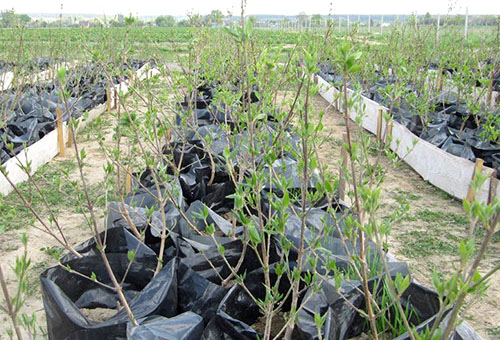
Where to get planting material
Ready-made seedlings can be purchased at nurseries. Two-year-old trees with a height of about 1.5 m take root well. They must have a fairly thick trunk - at least 2 cm in diameter - and 5 main branches. It is advisable to purchase varieties bred in your region, they do not have to adapt to new conditions.
If you prefer planting from your own prepared material, you can use one of the methods:
- planting seeds;
- layering;
- cuttings;
- root suckers;
- dividing the bush;
- budding.
For residents of the northern regions, where selection varieties of dogwood die from frost, the only way to grow this shrub is to plant seeds. Take seeds from different varieties of fruits, sow them and see how the plants survive.Dogwood will not retain all varietal qualities with this method of reproduction, even from berries from one bush trees with different properties can develop. For several years, observe how the bushes endure the winter, what harvest they give, and leave the best specimens. From them you can take cuttings and layering for further propagation.
Advice
If you want the dogwood seeds to germinate quickly, keep them in a 2% sulfuric acid solution for 3 days, and then sow them in wet sand, keep them in a warm place and make sure that the soil surface does not dry out. The grains will begin to hatch after 3 months.
Low branches in spring can be pressed to the ground and covered with soil. Make small trenches in the soil and place one-year-old shoots in them. Cut off the top so that the main forces go to the formation of roots. If provided with proper care, the shoot will take root by the fall. Cut it off from the main bush and you have a seedling ready to plant.
Often new shoots can be seen around the bush growing from the roots. You can dig up a scion with a fragment of the underground part and transplant it to a new place. Such a planting is not suitable for grafted plants: if a wild bush was taken for the stock, then the offspring will be wild.
You can divide an adult shrub into parts, but each piece should have a good root system and a strong aerial part. This work can be carried out either in early spring or in autumn before frost.
Another way is to plant green cuttings from mature bushes.
Important!
If solid wood has already formed inside the shoot, the cutting will not take root.
Cut twigs 10-15 cm long with two pairs of leaves. Remove the bottom pair and treat the cut with a root growth stimulant. Stick the shoots into the soil, sprinkled with a thick layer of clean sand and equip the shelter with film. 2-3 weeks before rooting, keep the planting at a temperature of about + 25⁰ and protect from bright sun. The soil must be constantly moistened. When the seedlings take root, feed them with ammonium nitrate. For the next fall, young plants can be relocated to a permanent place.

How to plant dogwood
You can grow seedlings from seeds if you like. Perhaps they will make a fruitful tree or a good stock for budding. Grains require a long stratification, they need to be kept in the refrigerator for almost a year. When sowing, keep in mind that the bone does not open, a small hole appears in it, through which a weak sprout emerges. If you bury the seeds deeper than 3 cm, the seedlings may not break through. Shoots grow very slowly, they need care, and the tree will begin to bear fruit only after 7 years. Dogwood loves to surprise gardeners. If ripe fruits germinate for more than a year, then unripe seeds may sprout after 6 months.
Wild dogwood seeds can be used to grow a good rootstock for a varietal bush. Sow many different grains, the sprouts will not take up much space on the site, but you can choose the strongest and most hardy seedling. At the age of 2 years, when the bush takes root well after transplanting, it can be grafted. In the middle of summer, cut a bud with bark and a small layer of wood from the plant you like. A cross-shaped incision is made horizontally and vertically on the rootstock. A scion is inserted into a vertical slot and fixed with a special tape or tape.
All shoots below the grafting site on the rootstock must be cut off. Make sure that the plant does not release new wild branches. After a month, the fixing tape must be removed. Grow the bush in the usual way. Next spring, new shoots will appear from the bud, and after 2 years you will taste the first fruits.
Advice
If you want to grow different varieties of dogwood, and there is only enough space on the site for 2 bushes, plant each tree with several buds of different varieties.
When growing fruit trees, grafting of young shoots is often used, but here, too, the dogwood shows its individuality.In early spring, before the growing season, you can try grafting a cutting. This method rarely gives results, despite careful care, shoots grow poorly. If, with skillful budding, up to 70% of the kidneys take root, then a successful vaccination is no more than 20%.
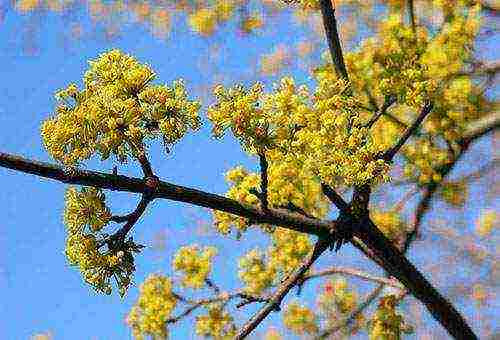
Shrub planting
You need to plant dogwood in the fall. Each region has its own time when it is necessary to start this work. Popular wisdom recommends: the most effective planting occurs at the time when the poplar began to shed its leaves. In the spring, in the middle lane, it is very difficult to guess the right time for planting: the period when the soil is already warming up, and the buds have not yet begun to bloom.
Dig holes with a depth and diameter of 80 cm at a distance of about 5 m from one another. Drive a stake into the ground from the direction of the prevailing winds, it will hold the tree in windy weather. Place the seedling behind the stake and bury it so that the root collar is a few centimeters above ground level. After watering and rains, the soil will settle, and it will take the desired position. First, pour fertile soil from the top layer into the hole so that the roots take root in the nutrient medium. Spill the soil well with water and tie the trunk to a peg. After a heavy downpour, make sure that the depth is calculated correctly: if the planting is high and the root collar is above the ground, the bush will develop poorly, and when deepened, it will give many root suckers, which will make it difficult to care for the plant.
Some gardeners believe that all branches of the seedling need to be shortened by a third, others do not, and the tree takes root well. What to do is up to you, you can cut off the shoots on one bush, but not on the other and see how it is best. Do not forget that each site has its own soil, its own microclimate, therefore, the cultivation of crops takes place according to different schemes. Any recommendations should be checked in practice, each owner should have individual experience and knowledge about what kind of care his pets need.

Does an unpretentious dogwood need care
Keeping a dogwood tree is easy, but you can make the job even easier if you cover the ground around the trunk with a thick layer of mulch after planting. Make sure that the root collar is not covered, it should be in the air. Weeds will not break through the compost or mowed grass, the ground there will always be loose and moist. Dogwood roots are mainly located in the upper soil layer. In dry weather, you need to water the bushes, and it is better to organize a drip irrigation system.
From May to autumn, the shrub works hard: energy is spent on the formation of fruits, and on growing young shoots. For these processes to take place correctly, the plant needs a sufficient amount of nutrients. Use fertilizers with a predominance of nitrogen and phosphorus until mid-summer, and potassium is needed in the second half of the season. In nature, dogwood prefers calcareous soils, because without calcium, the growth and formation of fruits are impossible. If this component is not in the soil of your site, add it to the top dressing.
Frequent pruning of dogwood is not necessary. Before the growing season, only diseased, dry and broken branches should be cut to prevent them from becoming a source of infection. To give shape to a young plant, leave a short, about half a meter, stem and 5 skeletal branches. To rejuvenate plants over 20 years old, prune off branches that are 4 years old. In their place, new fruiting shoots will appear. The tree tolerates shearing well, and if you want to use it as an ornamental plant, you can give the crown an unusual shape.
Dogwood is resistant to diseases and pests, and proper care will make the bush even stronger. And yet, do not forget to inspect the plant from time to time in order to notice problems in time.
- Powdery mildew - white bloom on the shoots. Treat the plant with colloidal sulfur.
- Rust - yellow spots on the leaves. The bush must be sprayed with Bordeaux liquid.
- Spotting.Bordeaux liquid will also help from this disease.
- Snail worm. The pest is destroyed with lime.
- The caterpillar is a multiflora. Sprinkle the dogwood with Parisian greens.
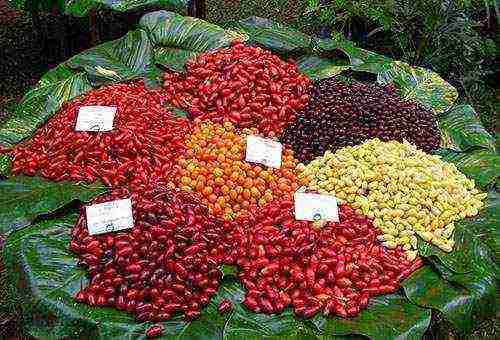
Conclusion
Dogwood can be grown and harvested not only in the south, but also in the northern regions. If the plant is properly cared for, it will bear fruit for up to 100 years. You can keep one trunk and grow the dogwood as a tree, or you can leave the lower shoots alone and get a bush.
In order for the dogwood to develop well and bear fruit, you need to choose the right varieties and planting method. Growing from seeds is a laborious task, but sometimes only this method is possible in the northern area. Good results are obtained by budding: on a winter-hardy rootstock, you can try to grow shoots of delicate varieties.
Dogwood is tenacious and unpretentious, it will endure any conditions. Does the plant need care? If you want to eat enough berries, do not forget about watering and feeding. You can leave the bush completely unattended, but it will not give good yields. Love your green pets, and your site will always be beautiful and productive.
